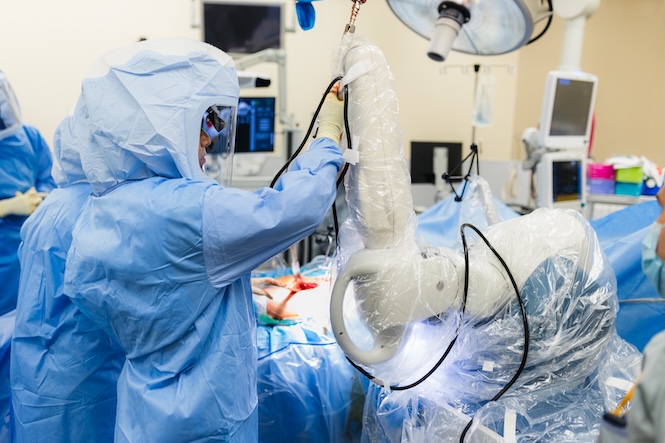
Orthopedic surgeons at Hamilton Health Sciences (HHS) Juravinski Hospital and Cancer Centre (JHCC) performed their first hip replacement surgery this month using a new, state-of-the-art orthopedic surgical robot designed specifically for hip and knee replacements.
The Mako Rio Surgical Robotic System is considered the most accurate and advanced robotic surgical system in the world for hip and knee replacements, including partial knee replacements which can be complex surgeries.
The system is currently being used at JHCC for hip replacements only, with plans to expand to knee and partial knee replacements. The HHS Foundation contributed $300,000 in funding, to support 200 robotic hip procedures per year at JHCC.
“It’s so encouraging to see how the innovation and commitment to quality at Juravinski Hospital and Cancer Centre, combined with the generosity of community donors, can create such impactful outcomes,” says Anissa Hilborn, chief executive officer for the HHS Foundation.
“So many lives will be changed for the better, and that should be an incredible source of pride for this region.”
Greater precision
Orthopedic surgeons use the robot for greater precision when preparing a bone for the implant, and accurately placing the replacement joint. The robot performs the procedure, with the surgeon maintaining overall control of programming and robotics.
“The robot is assisting to give surgeons more precision,” says Dr. Kamal Bali, an HHS orthopedic surgeon and clinical teaching unit director for resident doctors at JHCC. “This will potentially further reduce risk of both short-term and long-term issues with hip replacements like dislocation and premature wearing out of an artificial hip.”
Bali is the first JHCC surgeon to use the robot along with Dr. Daniel Tushinski, head of service for JHCC orthopedics and McMaster University’s orthopedics and spine fellowship director.
Hamilton Health Sciences surgeons specializing in joint replacement and reconstruction are among leaders in the province for minimally invasive, muscle-sparing hip replacement surgery. “Using robotic technology will further add to our hospital’s reputation as a centre of excellence in joint replacement surgery,” says Bali.
The hospital performs 800 to 1,000 hip replacements each year, and the 200 patients per year receiving their surgery with the robot will be selected on a case-by-case basis. Tushinski and Bali hope to see the program eventually expanded so that this technology could be offered to all patients needing hip replacements.
Benefits to patients
Damage from arthritis is the most common reason for needing a hip replacement. Left unchecked, inflammation can lead to significant damage, causing a loss of function and disability. Arthritis can impact almost any part of the body, but most often affects the hip, knee, spine or other weight-bearing joints. One in five Canadians lives with arthritis, and there’s no cure, according to Arthritis Society Canada.
Surgery can reduce pain and help people become more mobile, so they can once again enjoy their daily activities.
“People’s quality of life is vastly improved through hip and knee replacements,” says Tushinski. “As well as having less pain and increased mobility, they also have improved energy levels because they’re not constantly disabled by pain.”
Advancing research
Research suggests that patients whose surgeries used the robot enjoy a smoother and faster recovery with less pain and less chance of complications, such as wearing out the new joint
prematurely.
Hamilton Health Sciences is a top 10 Canadian research hospital, and having the surgical robot opens the door for new JHCC-based research aimed at improving outcomes for patients undergoing joint replacements, says Tushinski.
By Lise Diebel
Lise Diebel works in communications at HHS.

